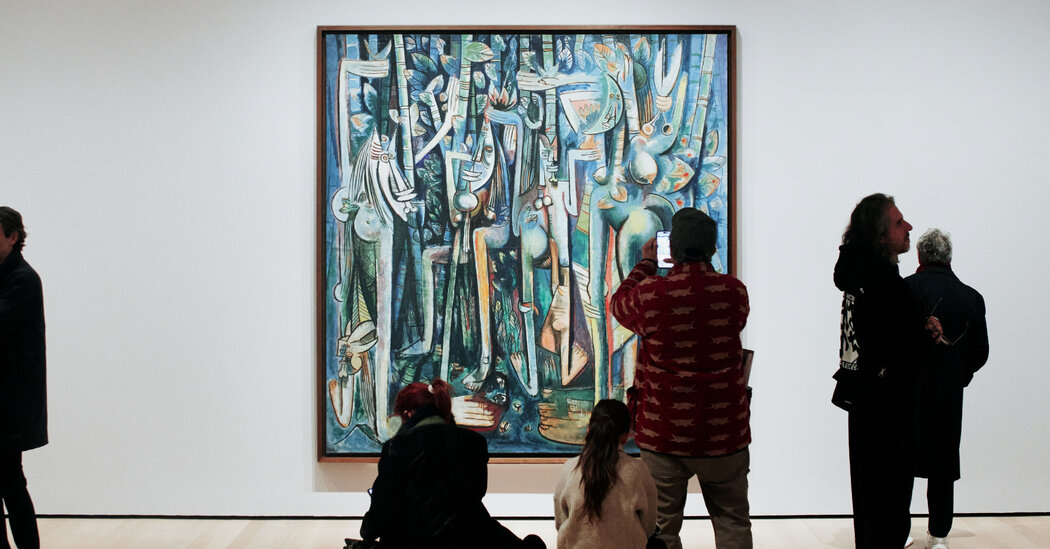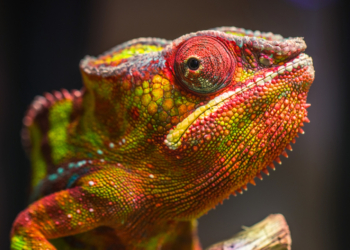
Art history, which likes categories and keeping things neat, has never known what to do with certain artists, Wifredo Lam (1902-1982) being one. Surrealist? Cubist? Latin American? Afro-Asian? Insider? Outlier? Yes. No. Sort of. Maybe.
So how about we go with Unclassifiably Fabulous Visual Poet? Even a speed-walk through the Museum of Modern Art’s blazingly hallucinatory retrospective, “Wifredo Lam: When I Don’t Sleep, I Dream,” will confirm that, whatever else Lam is, he’s definitely that.
And like many artists, he was his own most eloquent explicator. In an interview he said, “I have been considered a painter of the School of Paris, a Surrealist painter, but never as a representative of the painting that I really do and in which I believe I reflect, to a large extent, the poetry of the Africans who came to Cuba, poetry that still hides much pain in its songs.”
Organized by MoMA’s new director, Christophe Cherix, with Beverly Adams, curator of Latin American Art, and others, the show is the first in the United States to document the full arc of Lam’s career. And it begins, usefully, early, mapping the indirect path that brought Lam to be the artist-poet of his self-description.
He was born in Cuba in 1902, in a sugar-cane-harvesting region, to an immigrant Chinese father and a mother of West African and colonial Spanish descent. Most accounts of his life add a third parental figure, Ma’ Antonica Wilson, a priestess of the Afro-Cuban religion of Santeria, who served as his spiritual godmother.
His parents noted his drawing skills when he was young and sent him to art school in Havana. In 1923, he received a government scholarship earmarked for young persons “of color” and traveled to Spain for further study. For some years there he seems to have stuck with academic fare — still life, landscape — and a realist style, with at least one arresting exception in the form of a Fauve-ish painting of an ambiguously gendered dark-skinned figure wrapped in a florid Chinese robe. A self-portrait?
In 1930 he married and had a child, supporting his new family, precariously, with portrait commissions. Disaster hit. Both his wife and 1-year-old son died of tuberculosis. Grief, it seems, broke Lam down, but also opened him up. He went deeper into art, updating himself on new developments in Paris and the rest of Europe. And he got politically active, joining the Republican army at the start of the Spanish Civil War, a grueling commitment that, in 1937, produced his first major painting.
Titled “La Guerra Civil (The Spanish Civil War),” and done on the cheap, mostly in blue and black gouache on a big sheet of commercial packaging paper, it’s a scene of Fascist troops slaughtering Spanish citizens. The painting style — a chaos of swipes and blotches in a dimensionless space — is half-abstract, but the bad-dream emotion conveyed, of a world in a state of emergency, is specific and strong, a dynamic Lam will recreate in future work.
In 1938, exhausted, he left Spain for Paris, and there a new story starts. On arrival he is embraced by Picasso and the poets and artists of the Surrealist wave. In quick order, he sets up a small studio, lands a gallery, and scores the sale of brand-new work — a Cubist pieta of a picture called “Mother and Child” (it’s in the show) — to MoMA.
But World II has now started. German troops are in Paris and the art world is streaming out, heading south to Marseilles and from there across the Atlantic to safety. Camped-out life in Marseilles must have been quite a scene, a big, scared party. Artists and writers passed some of this tense time playing the Surrealist game called “Exquisite Corpse,” in which, collectively, they made composite figurative drawings and collages, with each player contributing a part of the image.
Lam participated in the game, and the fantastical, often grotesque imagery that resulted seems to have established a stylistic touchstone for his painting to come. And the sea voyage itself clarified an existing content that was waiting to be revealed.
On the ship’s first stop, in Martinique, Lam met the Black poet and politician Aimé Césaire, shaper of the Negritude movement. They shared an instant rapport and would become collaborators. And partly because of this bonding, when Lam ended his trip in Cuba, landing there for the first time in 18 years, he was ready, in a way he had not consciously been before, to focus his attention on the Afro-Atlantic culture that was his heritage.
It was through changed eyes that he saw the tropical island he’d left. Lush and green, it was still a natural paradise, but one despoiled by centuries of Western colonialist racism and greed. In a late-life interview with the Cuban critic and curator Gerardo Mosquera, Lam labeled the art he would make from that time forward “an act of decolonization.” And once back in Cuba he got right down to it, producing, in 1943, the monumental astounder of a picture titled “La Jungla” (The Jungle).
If spatial depth in “La Guerra Civil” was depicted as an abstract whiteness, like fog, in “La Jungla” it’s all but blocked from view by a crowd of upright figures jammed together against a solid wall composed of stalks of sugar cane, the money crop for which African men, women and children, shipped to the Caribbean as enslaved people, were forced to do the crushing work of harvesting.
But the figures gathered here, some with faces resembling Picassoid versions of African masks, don’t appear to be slaves. Of indeterminate species, they don’t represent “the Africans who came to Cuba,” but the cultural essence of Africa itself. The picture, with its palette of succulent greens and mango-yellows, is a classical pastorale of a kind Lam knew from European art history, transformed by the energies of the living Afro-Caribbean spirituality he experienced in childhood, without ever becoming a practitioner.
And those energies infused almost all the art he made from that point on. They certainly animate the even more spectacular, mural-size painting-on-paper titled simply “Grande Composition.” (Completed in 1949, and recently acquired by MoMA, it’s been out of sight for 60 years, and is being shown in the United States for the first time.)
Here the palette is subdued — black, white and brown; shadow-and-light — but the contents are even more determinedly multicultural, with spiritual power-figures — a horse-headed woman, lifted straight from Afro-Cuban sources — accompanied by images of Native American and Oceanic masks, all set in frieze-like silhouette against a dark ground.
Later, figures will decrease in number and become crazily, almost comically abstract, as in the 1955 painting from which the exhibition takes its name. And then, in a handful of pictures from the late 1950s, they will disappear altogether, replaced by dense fields of floating lines suggesting smoldering earth, sacrificial pyres and cosmic conflagrations.
Political and poetic, ideally mutually inclusive terms, are equally apt descriptions for these paintings, and for all of this cosmopolitan artist’s work and thought. (Lam moved permanently from Cuba to Europe in 1952, and traveled internationally throughout his life, finally settling in Italy.)
Although initially leery of the critical notion of biography-as-destiny — the idea that a lived life might be used as absolute measure of the meaning and worth of what it produced — he understood, at a fairly early point, that the experience of otherness, which was his experience as an Afro-Asian Latino, came with insights and obligations that would and should shape his art.
In this regard, Lam has much to say to succeeding generations of artists. And the exhibition catalog concludes with a small album-like group show of some who acknowledge his influence, including McArthur Binion, Mel Edwards, Teresita Fernández, Raphael Ferrer, Rashid Johnson, Ana Mendieta and Maria Magdalena Campos-Pons. And to which company I would add the names of two extraordinary Cuban artists now gone, Belkis Ayón (1967-99) and Juan Francisco Elso (1956-88).
As for “poetic,” Lam adored poetry. He said so again and again. He found it in many forms and places. And poets found it in him. In 1941, André Breton chose Lam drawings to illustrate his book-length poem “Fata Morgana,” creating one of Surrealism’s landmark word-and-image collaborations. Lam later provided illustrations for history-altering poetry books by Aimé Césaire, René Char and Édouard Glissant. And in 1982, the last year of his life, a collaboration was flipped when Césaire, in a gesture of tribute, added his poems to a portfolio of Lam’s prints.
The MoMA retrospective is also a tribute, though it doesn’t call itself that.
Perfectly proportioned, beautifully installed, it lets a figure who has long been defined by associative labels be the distinctive and peerless artist-poet he was.
Wifredo Lam: When I Don’t Sleep, I Dream
Through April 11, 2026, at the Museum of Modern Art, 11 West 53rd Street, (212) 708-9400; moma.org.
Holland Cotter is the co-chief art critic and a senior writer for the Culture section of The Times, where he has been on staff since 1998.
The post Wifredo Lam: Artist-Poet of Tropical Dreams and Sorrows appeared first on New York Times.



